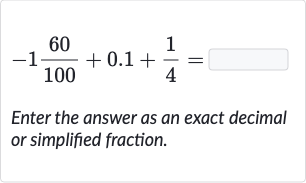AI tutor
Welcome to Bytelearn!
Let’s check out your problem:

Enter the answer as an exact decimal or simplified fraction.
Full solution
Q. Enter the answer as an exact decimal or simplified fraction.
- Convert Terms to Fractions/Decimals: Convert all terms to fractions or decimals to simplify the calculation. can be simplified to . is the same as when converted to a fraction. is already in fraction form.
- Simplify Fractions: Simplify the fractions. can be simplified by dividing both the numerator and the denominator by , which gives . is already in simplest form. is already in simplest form.
- Add Fractions with Common Denominator: Add the fractions together.To add fractions, they need to have a common denominator. The common denominator for , , and is .Convert to by multiplying both the numerator and the denominator by .Convert to by multiplying both the numerator and the denominator by . is converted to by multiplying both the numerator and the denominator by .
- Add Converted Fractions: Add the converted fractions.Now, add , , and together.
- Simplify Final Result: Simplify the result. can be simplified by dividing both the numerator and the denominator by , which gives .
